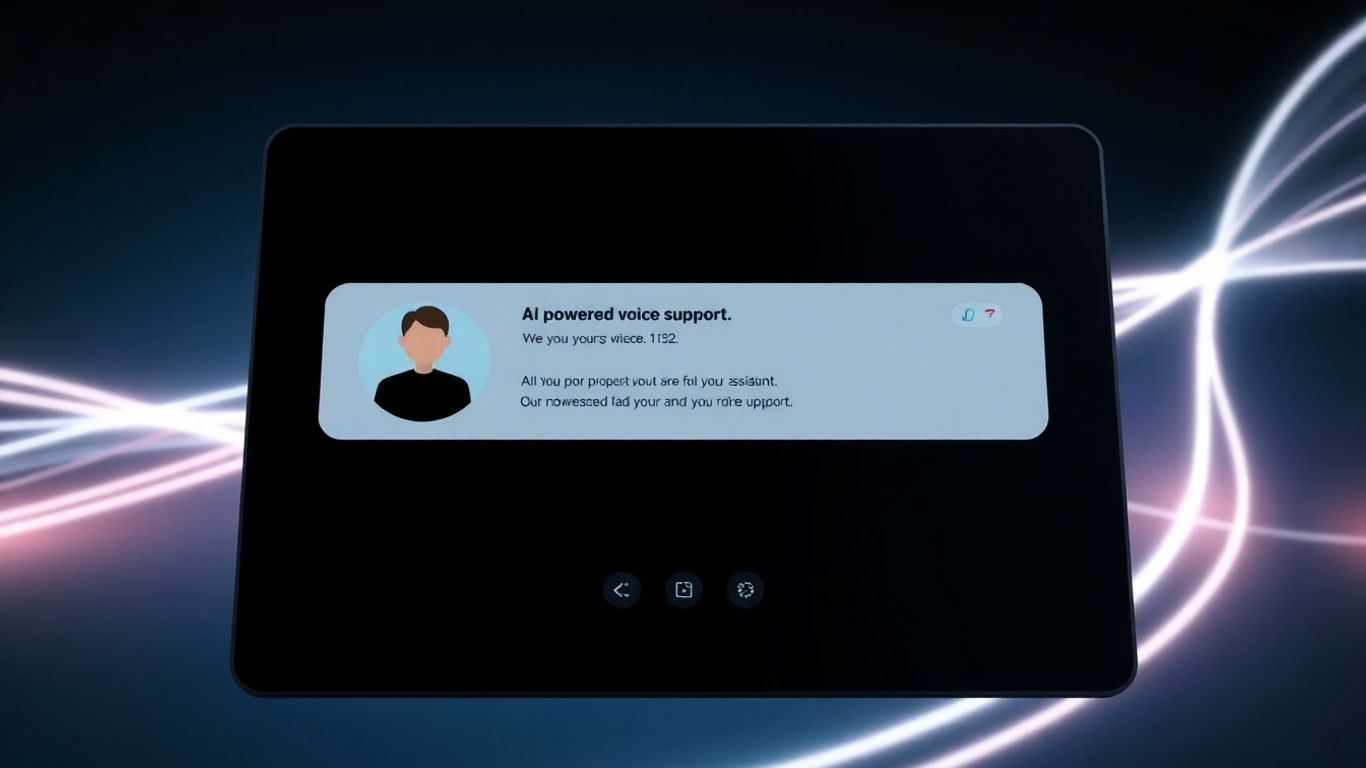Looking for ways to make your customer support smarter and faster in 2025? You're in the right place. We've been checking out the latest in voice AI, and let me tell you, the options are pretty wild. These tools are getting so good at handling calls, answering questions, and even booking appointments. It's like having a super-powered assistant that never sleeps. If you're trying to figure out the best voicebot solutions for AI support, stick around. We've rounded up some of the top contenders that could really change how your business handles customer interactions.

Sobot Voicebot is making waves as a voice-first AI agent platform, aiming to give businesses a smarter, more unified way to connect with their customers. It’s not just about answering calls; it’s about having intelligent conversations that can actually solve problems. This platform is designed to handle a significant chunk of customer interactions on its own, freeing up human agents for the really tricky stuff.
What sets Sobot apart is its tech. It uses real-time speech recognition and natural language processing, powered by big names like ChatGPT and Claude, which means it’s pretty good at understanding what people are saying and not making things up. They claim it can handle over 50% of inbound customer queries independently. Plus, it’s not limited to just voice; it works across chat, email, and social media, so customers get a consistent experience no matter how they reach out.
Here’s a quick look at what it can do:
Sobot also emphasizes security and compliance, which is a big deal for industries like finance and healthcare. They’ve got data centers in different regions and meet global privacy standards. It’s built to be scalable, so whether you’re a small startup or a large company, it can grow with you. They even have a visual builder, making it easier to set up and manage without needing a whole team of developers. It’s a solid option if you’re looking to automate customer interactions and improve efficiency, especially if you need a solution that can handle a lot of different communication channels. You can check out how AI chatbots are changing the game for lead generation.
The goal here is to make customer interactions feel more natural and less like talking to a robot. By understanding language nuances and providing relevant recommendations, Sobot aims to create a better experience for everyone involved. It’s about making technology work for both the customer and the business, streamlining processes and improving satisfaction.

So, you're thinking about automating your front desk, huh? It's a pretty smart move these days. Think of it like having a super-efficient receptionist who's always on, never calls in sick, and can handle a ton of calls at once. That's basically what an AI front desk does.
These systems are designed to be the first point of contact for your customers. They can answer common questions about your business, schedule appointments, and even handle inquiries outside of normal business hours. It's not just about picking up the phone; it's about providing a consistent and helpful experience, no matter when someone reaches out. The biggest win here is often the sheer speed and availability. Imagine a customer calls with a question right after you've closed for the day. Instead of getting a generic voicemail, they get a helpful, human-like response and can even book a service. That kind of instant support can make a huge difference in customer satisfaction and, ultimately, your bottom line.
Here's a quick look at what these AI receptionists can do:
Setting up these AI front desks is surprisingly straightforward. You typically provide the AI with information about your business, and it's ready to go. Some systems even offer free trials, so you can test them out before committing. It's about making your business more accessible and efficient without adding to your human staff's workload.
The real power of proactive outreach with AI lies in its ability to anticipate needs and communicate solutions before problems even arise. It shifts the customer service paradigm from reactive problem-solving to proactive relationship-building, ultimately leading to higher satisfaction and loyalty.
Kore.ai is a platform that lets you build conversational AI agents, often called IVAs (Intelligent Virtual Assistants). They offer both no-code and low-code ways to get these bots up and running, which is pretty handy if you don't have a huge development team. It supports a lot of different channels, like messaging apps and websites, and handles many languages too, making it a solid choice for businesses that operate globally.
One of the big draws here is the focus on enterprise-grade security and compliance. This means if you're dealing with sensitive customer data, Kore.ai has features built in to help keep things locked down. They also provide tools for reporting and analytics, so you can actually see how your bots are performing and where you might need to make adjustments.
Key features often highlighted include:
The platform aims to simplify the creation and management of complex conversational AI, allowing businesses to automate customer service and internal processes without needing deep technical skills for every step. It's designed to scale with your business needs.
Kore.ai integrates with popular business tools, helping to connect your AI agents with your existing workflows. This can make things like customer service or internal support much smoother. If you're looking for a platform that offers flexibility in how you build your bots and strong security for your data, Kore.ai is definitely worth a look. You can check out their AI chatbot solutions for more details on how they help automate customer interactions.
Uniphore is a big player in the conversational AI space, and they've got a pretty solid voicebot solution that's aimed at enterprises. They really focus on making interactions feel more human, which is something a lot of companies are looking for. Their platform combines AI with automation to handle customer conversations across different channels, not just voice.
What's interesting about Uniphore is their approach to blending AI with human agent support. They talk a lot about "intelligent automation" and how their voicebots can handle routine tasks, freeing up human agents for more complex issues. This means fewer dropped calls and, hopefully, happier customers and agents.
Here's a quick look at some of their key strengths:
Uniphore's platform is built to scale, meaning it can handle a large volume of calls without a hitch. They also put a lot of emphasis on security and compliance, which is a big deal for larger organizations that have to deal with sensitive data.
When you're looking at Uniphore, think about how their solution can integrate with your existing systems. They have a lot of experience working with big companies, so they're usually pretty good at making those connections happen. It's not just about having a voicebot; it's about how that voicebot fits into your whole customer service picture.

Retell AI is a player in the voicebot space that really focuses on giving you a lot of control over the AI models themselves. If you're a team that likes to tinker and wants to bring your own large language models (LLMs) into the mix, this is where Retell shines. They've built a pipeline that's designed for real-time voice interactions, meaning it's pretty quick on its feet. This is important because, let's be honest, nobody likes talking to a bot that pauses for ages before responding. It feels unnatural, right?
They've also put a big emphasis on making sure things are compliant, which is a huge deal for many businesses. We're talking about things like HIPAA, SOC 2, and GDPR. So, if you're in an industry where data privacy and security are non-negotiable, Retell AI has got that covered. It supports both inbound and outbound calls, so it's pretty flexible in how you can use it.
Here’s a quick look at what they bring to the table:
It's worth noting that while this flexibility is a big plus, it might mean a bit more setup on the engineering side compared to some other, more plug-and-play solutions. But if you're looking for that deep level of customization and control over your voice AI, Retell AI is definitely one to check out.

Ozonetel is stepping into the voicebot arena with a focus on GenAI-powered solutions designed for enterprises looking to really personalize self-service across the entire customer journey. They're building bots that don't just follow scripts but actually learn and adapt.
What sets Ozonetel apart is their approach to the underlying AI. They're using purpose-built LLMs that get smarter with every interaction. This means the bots can pick up on caller intent, pull information from your knowledge base, and give responses that actually make sense in the context of the conversation. Plus, they've got these skill-based transfer nodes, so if the bot can't handle something, it knows exactly who to pass it off to.
Think about it: you're calling a company, and the bot doesn't just give you a canned answer. It understands you're asking about a specific order, checks your account, and tells you the status, all while matching your pace so it feels like a real chat. That's the kind of predictive, personalized experience Ozonetel is aiming for.
The goal here is to move beyond basic IVR systems and create voice interactions that feel genuinely helpful and intuitive. By continuously learning from customer calls, Ozonetel's bots aim to become more accurate and natural over time, reducing frustration and improving overall customer satisfaction.
Key features to look out for:
Convozen AI is really trying to make a splash by focusing on voicebots that can handle a lot of different languages and understand how people are feeling during a conversation. They're aiming at businesses that need to talk to customers in various regions and in their local languages, which is a big deal for global companies.
What's pretty neat about Convozen is their focus on sentiment-aware responses. This means the bot doesn't just hear words; it tries to pick up on the emotion behind them. If someone sounds frustrated, the bot might adjust its tone or offer a different solution. They also have this capability for WhatsApp voice bots, which is interesting because it opens up communication for people who might not be as comfortable with text or have lower literacy rates. It's like giving more people a way to interact with businesses easily.
Here's a quick look at what they bring to the table:
Convozen AI seems to be building tools for a world where communication needs to be more personal and accessible, especially across different cultures and languages. They're trying to bridge gaps by making voice interactions smarter and more empathetic.
Their approach is particularly useful for companies looking to connect with diverse customer bases without the massive overhead of hiring multilingual support staff for every single language. It's about using AI to make customer service feel more human, even when it's automated.
Lindy is a voicebot platform that really shines for small to mid-sized businesses, especially those looking to run outbound campaigns or qualify leads. What sets Lindy apart is its user-friendly drag-and-drop builder, which comes packed with over 100 templates to get you started quickly. You don't need to be a coding wizard to build sophisticated conversational flows.
One of the really neat things about Lindy is its multilingual support, meaning you can reach a broader audience without a ton of extra work. Plus, they give you the option to select your own Large Language Model (LLM). This is pretty cool because it means you can tailor the AI's reasoning capabilities to your specific needs without sacrificing the ease of use that the drag-and-drop interface provides. It’s a nice balance between power and simplicity.
Lindy also plays well with others, offering integrations across various tools you might already be using. This makes it easier to fit Lindy into your existing workflow. They also offer a usage-based pricing model, which can be quite attractive for businesses that want to pay for what they use rather than a fixed subscription.
Here’s a quick look at some of Lindy’s strengths:
Lindy seems to hit a sweet spot for businesses that need a capable voicebot without the complexity often associated with enterprise-level solutions. The ability to choose your LLM is a significant advantage for those wanting more control over the AI's performance, while the templates and intuitive builder make it accessible for teams of all technical backgrounds. It’s a solid choice for streamlining outbound efforts and lead qualification.
Vapi is a voicebot platform that really leans into its developer-first approach. If you're an agency, an AI consultancy, or a dev team looking to build something custom, this is probably going to be right up your alley. They offer a ton of flexibility, letting you bring your own model keys for things like text-to-speech (TTS) and large language models (LLMs). This means you're not locked into their specific tech stack and can use the best tools for your project.
What really sets Vapi apart is the control it gives developers. You get access to thousands of templates, which is a great starting point, but the real power comes from being able to tweak and customize everything. They also have a pay-as-you-go model, which can be really attractive for projects with variable usage. Plus, their focus on A/B testing at scale and broad language coverage means you can build and refine sophisticated voice applications that work for a global audience.
Here's a quick look at what Vapi brings to the table:
Vapi's approach is all about giving builders the tools they need to create highly specific and powerful voice automation. It's less of an out-of-the-box solution and more of a robust framework for those who want to engineer their own voice experiences from the ground up. The emphasis on developer freedom means you can really tailor the voice, the logic, and the integrations to fit exact business needs, which is pretty neat if you've got the technical chops.
While it might have a steeper learning curve than some no-code platforms, the payoff is a truly bespoke voicebot solution. It's ideal for teams that need fine-grained control over every aspect of their voice AI.
Synthflow is a voicebot builder that really aims to make things easy, especially for folks who aren't super technical. Think drag-and-drop simplicity, kind of like putting together building blocks, but for creating voice assistants. They’ve got these ready-made templates too, which can speed things up a bunch if you’re in a hurry.
What’s cool is that it supports multiple languages, so you’re not stuck with just English. Plus, they boast over 200 integrations, meaning it can probably connect with a lot of the other tools your business already uses. This makes it pretty flexible for different kinds of setups.
Synthflow is particularly good for small to medium-sized businesses, agencies, and teams that need to get a voicebot up and running quickly without a huge learning curve. While it’s accessible for non-engineers, they also mention enterprise-level security for their higher-tier plans, which is a nice touch if you’re a growing business with more complex needs.
They seem to focus on making AI-powered product recommendations for e-commerce and offer real-time analytics. This means you can see how your voicebot is performing and maybe tweak things to boost sales. It’s not just about having a voicebot; it’s about making it work for your business goals.
The whole idea behind Synthflow is to democratize voicebot creation. They want anyone, regardless of their coding background, to be able to build and deploy sophisticated voice AI solutions. It’s about removing the technical barriers so businesses can focus on the customer experience and the outcomes they want to achieve.
If you’re looking for a no-code solution that’s quick to deploy and can handle multilingual interactions, Synthflow is definitely worth a look. It’s designed for speed and ease of use, which can be a real lifesaver when you’re trying to get a new project off the ground.
Discover how Synthflow can help you manage your business communications. Our advanced AI tools are designed to make your daily tasks easier and more efficient. Want to see it in action? Visit our website to learn more and get started today!
So, we've looked at a bunch of voicebot tools that can really help out with customer support. It’s pretty wild how far this tech has come, right? These systems can handle calls, answer questions, and even book appointments, all without a human needing to lift a finger. Picking the right one really depends on what your business needs, like if you're a small shop or a big company, and what kind of problems you're trying to solve. But one thing's for sure, these AI helpers are here to stay and are changing how we talk to customers. It’s worth checking them out to see how they can make your life a little easier and your customers happier.
Think of an AI voicebot as a super-smart robot that can talk to people over the phone or through voice commands. It's designed to understand what you say and respond in a way that sounds natural, just like a human. These bots can answer questions, schedule appointments, and help customers with their needs, all automatically.
Getting started is usually pretty fast! Many services let you set up your AI voicebot in just a few minutes. You'll typically tell it about your business, make a payment, and then it's ready to start taking calls or handling requests.
Absolutely! One of the biggest advantages of AI voicebots is their ability to handle many calls all at once, without getting overwhelmed. This means no more busy signals for your customers, even during really busy times.
Yes, most modern AI voicebots are designed to sound very natural and human-like. They use advanced technology to understand different accents and speak clearly, making conversations feel smooth and easy.
Many AI voicebots can connect with your other software, like your calendar or customer relationship management (CRM) system. This means they can automatically update appointments or add customer information, saving you a lot of manual work.
While there's an initial cost, AI voicebots are often much cheaper than hiring human staff to do the same job, especially when you consider they can work 24/7. Many services offer different plans to fit various budgets.
AI voicebots can answer a wide range of questions about your business. You train them with information about your products, services, hours, and policies. They can then use this knowledge to answer specific customer questions accurately.
Many companies offer free trials for their AI voicebot services. This is a great way to test out the features and see how well it works for your business before committing to a subscription.
Start your free trial for My AI Front Desk today, it takes minutes to setup!








